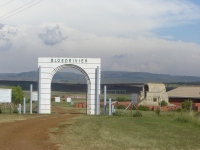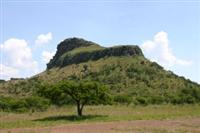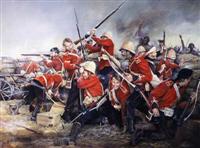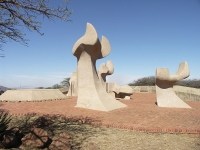Things to do in Battlefields
The Battlefields Route covers 14 historical towns, including Ladysmith and Dundee, numerous national monuments and informative museums, and over 50 battlefields in the surrounding countryside. These are best explored on a self-drive adventure or as part of a tour. If visitors are confident drivers, self-driving is probably best as they can take their time and divert off the route to see lesser known attractions.
Zululand is a beautiful area and the scenic splendour of some of the battle sites, many of which now seem to be in the middle of nowhere, is poignant. Many of the battles that took place outside of towns and settlements are now marked only by graves among the long grass and rolling hills. At some sites there are museums and memorials but, at others, visitors will need to use some imagination to recreate past events.
Every town on the route has a story to tell or an event to commemorate said story. Tourism offices throughout the region provide maps and guides to assist visitors in making the most of the history, culture, scenery and wildlife.
Exploring this region is a must for military history buffs on holiday in South Africa, though even those who generally aren't interested in these sorts of attractions will be moved by the stories of courage and brutality, and by the lovely landscapes.

Blood River Heritage Site
Following a long period of conflict and mistrust, including the treacherous murder of Voortrekker leader, Piet Retief, and his companions at the hands of the Zulu chief Dingaan, th…
Blood River Heritage Site
Following a long period of conflict and mistrust, including the treacherous murder of Voortrekker leader, Piet Retief, and his companions at the hands of the Zulu chief Dingaan, the Voortrekkers, led by Andries Pretorius, prepared for battle against the Zulu kingdom on the banks of the Ncome River on 16 December 1838. The 460 Voortrekkers formed an impenetrable laager, a defensive camp encircled with their ox-wagons, and fought the 15,000-strong impi attack until the Zulus finally retreated, leaving thousands dead and the river red with blood. The violent encounter became known as the Battle of Blood River. The Blood River, Ncome Heritage Site commemorates this significant battle with monuments and museums to both the Voortrekkers and the Zulus on both sides of the river.

Isandlwana Hill
The battle at Isandlwana Hill on 22 January 1879 stunned the British Empire in what was to be the worst defeat in their imperial history. The news that an entire battalion of Briti…
Isandlwana Hill
The battle at Isandlwana Hill on 22 January 1879 stunned the British Empire in what was to be the worst defeat in their imperial history. The news that an entire battalion of British troops had been wiped out by a 'native' army was unbelievable. Led by King Cetshwayo, the Zulu Kingdom had refused to submit to British rule and had been gaining strength. Consequently, it was perceived as a threat to British colonists. British troops were ordered to invade Zululand, but grossly underestimated the Zulu warriors. The surprise attack on the Isandlwana Hill British camp left hundreds dead. Isandlwana was the first major encounter of the Anglo-Zulu War. Today, the battlefield is dotted with memorials, and mounds of white stones that mark the British mass graves.

Rorke's Drift
Fought on the same day as the nearby battle at Isandlwana Hill, the Battle of Rorke's Drift is remembered as one of the most famous sieges of the Anglo-Zulu War. Survivors from Isa…
Rorke's Drift
Fought on the same day as the nearby battle at Isandlwana Hill, the Battle of Rorke's Drift is remembered as one of the most famous sieges of the Anglo-Zulu War. Survivors from Isandlwana fled to the Swedish mission station that was used as a British field hospital and storehouse, and sounded the alarm. Inside, the 139 men, many of them ill or wounded, barricaded themselves in and prepared for the onslaught of 4,000 Zulu warriors. The Battle Museum dramatically tells the tale of the 'Heroic Hundred' who desperately defended the station for 12 hours, until the Zulus finally retreated with a heavy loss of life. Though it's generally thought that the defenders' courage warranted recognition, the awards were also made to distract public opinion from the disastrous British defeat at Isandlwana.

Ladysmith Siege Museum
During the South African War, Ladysmith was besieged for 118 days between 2 November 1899 and 28 February 1900. Thousands died, either during battle or from disease and the lack of…
Ladysmith Siege Museum
During the South African War, Ladysmith was besieged for 118 days between 2 November 1899 and 28 February 1900. Thousands died, either during battle or from disease and the lack of food and water. Twenty-one thousand Boers advanced into Natal from all sides when war was declared between the Boer republics and Britain. After two notable battles, the Boer forces surrounded the garrison town of Ladysmith, where the British commander and his core force were deployed. The siege was eventually broken by the British when a relief force entered Ladysmith (a force which included a young Churchill). The museum is considered one of the best Anglo-Boer War museums in the country.
Website www.battlefieldsroute.co.za/place/ladysmith-siege-museum



